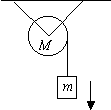- (A) the kinetic energy of the cannonball/cannon system is conserved before and after the firing.
- (B) the momentum of the cannonball/cannon system is conserved before and after the firing.
- (C) the kinetic energy of the cannon must equal the kinetic energy of the cannonball.
- (D) the momentum of the cannon is greater than the momentum of the cannonball.
- (E) the momentum of the cannon is less than the momentum of the cannonball.
- (A) Object 1 now moves to the left with speed v and Object 2 remains at rest.
- (B) Object 1 is now at rest and Object 2 moves to the right with speed v.
- (C) Both objects are now at rest.
- (D) Both objects move to the right with speed v.
- (E) Both objects move to the right with speed ½ v.
- (A) vA = ¼ vcart
- (B) vA = ½ vcart
- (C) vA = vcart
- (D) vA = 2 vcart
- (E) vA = 4 vcart
 | (A) ¼ W L (B) ½ W L (C) W L (D) 2 W L (E) 4 W L |
 | (A) g (B) 0 if M > m (C) < g (D) > g (E) < g, = g, > g depending on the relative sizes of m and M. |
- (A) Her angular momentum and angular velocity decrease;
- (B) Her angular momentum decreases and her angular velocity remains constant;
- (C) Her angular momentum remains constant and her angular velocity decreases;
- (D) Her angular momentum remains constant and her angular velocity increases;
- (E) Her angular momentum and angular velocity increase.
- (A) x and v reach maximum magnitude at the same time.
- (B) v and a reach maximum magnitude at the same time.
- (C) x and a reach maximum magnitude at the same time.
- (D) a is constant throughout the motion of the mass.
- (E) v is constant throughout the motion of the mass.
- (A) It depends on the spring constant.
- (B) It depends on the magnitude of the initial displacement from equilibrium.
- (C) It depends on the mass of the object.
- (D) It is the same whether the initial displacement compresses or stretches the spring.
- (E) It is positive when the mass is moving in the chosen negative direction.
- (A) a lesser additional pressure acts on the output plunger.
- (B) the same additional pressure acts on the output plunger.
- (C) a greater additional pressure acts on the output plunger.
- (D) the change in pressure on the output plunger cannot be determined since it depends on the ratio of the areas of the input piston and output plunger.
- (E)the change in pressure on the output plunger cannot be determined since it depends on the height difference between the input piston and output plunger.
- (A) It is greater when the ball is floating on the mercury;
- (B) It is greater when the ball is totally submerged in water;
- (C) It is the same in both cases (A) and (B);
- (D) Either (A), (B), or (C) may be correct depending on the mass of the steel ball;
- (E) Either (A), (B), or (C) may be correct depending on the volume of the steel ball.